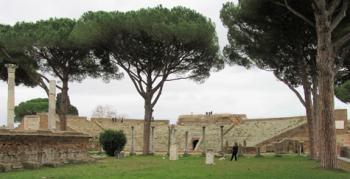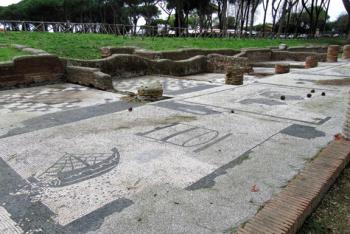Visit to Ostia Antica
This item appears on page 41 of the August 2018 issue.
Despite two visits to Rome, my wife, Paula Owens, and I had never managed to visit nearby Ostia Antica, ancient Rome’s seaport.
Located at the mouth of the Tiber River, Ostia Antica is less than an hour (by rail) from the heart of Rome. A Mediterranean cruise in January 2018 provided a good opportunity for us to finally visit this ancient coastal city from the ship’s port in Civitavecchia. Travel time was slightly less than an hour (by bus), 15 to 30 minutes less than taking a bus into Rome.
The most convenient departure point for a visit to Ostia Antica might be Rome’s Leonardo da Vinci-Fiumicino Airport, which is practically adjacent to the historic site. The stumbling block with that is finding somewhere to store your luggage during your visit.
Ostia Antica was founded in the 7th century BC. Eventually, the city’s population peaked at possibly around 100,000. However, Ostia Antica was slowly supplanted as Rome’s primary port by the newer city of Portus. After centuries of decline, the city was abandoned by the 9th century.
You enter the 120-acre site on a lane of stones and grass alongside a necropolis. Proceeding deeper into the city, you’ll find a large theater, public baths and latrines, private homes, a warehouse, shops and even cafés in various states of decay.
Due to its poor condition (it wasn’t buried under ash and mud for centuries like Pompeii and Herculaneum), it can be challenging to envision the bustling Roman city it once was.
In addition, for us, at least, its authenticity was spoiled by Mussolini’s overly ambitious restorations during the late ’30s and early ’40s. The resulting structures often don’t appear ancient and leave you wondering what is real and what is someone else’s vision of the past.
Like Pompeii and Herculaneum (May ’18, pg. 13), Ostia Antica has had its best statues, mosaics and frescoes moved to museums. Unlike those two cities, Ostia Antica is not a UNESCO World Heritage Site.
Visitors find little signage and few maps in Ostia Antica. Before you go, download the tourist guide at www.ostia-antica.org/touristguide.pdf, which includes a map and useful information. The official website (in Italian only) is www.ostiaantica.beniculturali.it.
Admission costs €10 (near $11.50) per adult. Ostia Antica is closed every Monday as well as New Year’s Day, May 1 and Christmas.
If you go, be sure to take advantage of the relatively new WCs just past the ticket office. (This area is a good place to pet and feed the friendly cats that live there.)
The only other services available are a pair of buildings on the site’s northwest side, about two-thirds of the way back from the entrance. There you’ll find a small museum, a café (hot meals and sandwiches), a gift shop and dilapidated WCs. Other than these buildings, there is no cover from sun or rain on the site other than the occasional stone roof and atmospheric umbrella pines.
If you have mobility issues, portions of the site will likely be inaccessible to you due to uneven walking surfaces of stones and earth (which can be very muddy after it rains).
Frankly, we were disappointed with Ostia Antica. The combination of Mussolini’s “restorations” and a general state of neglect turned us off. It didn’t help that we had fairly high expectations based upon Rick Steves’ articles and TripAdvisor reviews. I’d say you should visit Ostia Antica only if you can’t go to Pompeii or Herculaneum.
If you need a break from the hustle and bustle of Rome for a while, a day trip is a great idea, but I recommend taking the 1½-hour train ride to the hill town of Orvieto instead.
STEPHEN ADDISON
Charlotte, NC


